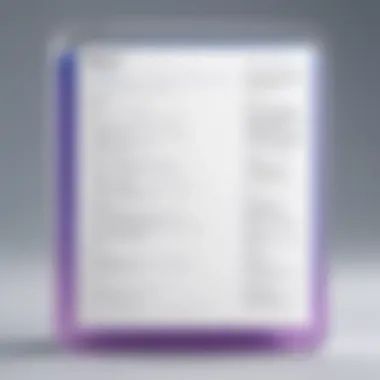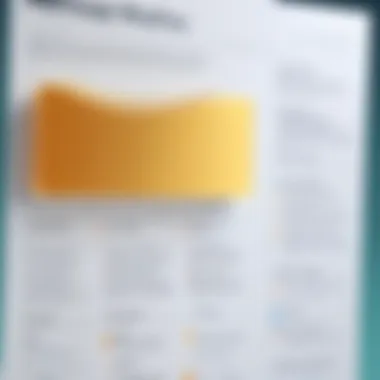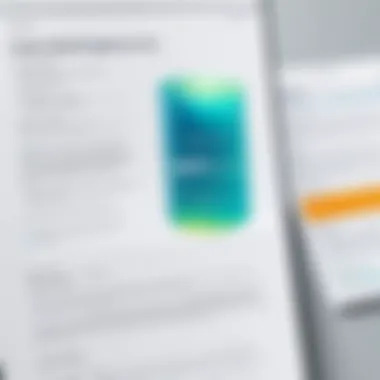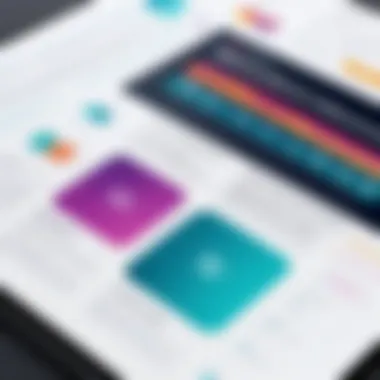Understanding PMHNP SOAP Notes in Mental Health Practice


Intro
In the realm of mental health care, documentation plays a paramount role. Among the various methods used, the SOAP note format stands out for its simplicity and effectiveness. These notes facilitate the comprehensive gathering of patient information while guiding practitioners through documentation that is systematic and clear.
In psychiatric mental health practice, properly constructed SOAP notes are essential. They serve not only as records of consultation but are vital for treatment planning and continuity of care. This article delves into the intricacies of PMHNP SOAP notes, shining light on their components and importance, so as to acknowledge their significant impact on patient outcomes.
Industry Overview
The practice of psychiatric nursing has evolved dramatically over the years, focusing increasingly on structured methods of communication and documentation. The rise of evidence-based practices has resulted in greater emphasis on creating notes that are clinically relevant yet retain integrity and clarity.
Current Trends in the Industry
- Standardization of Documentation: There is a concerted effort among health practitioners to standardize teaching and usage of SOAP notes within training programs.
- Integration with Electronic Health Records (EHR): The merging of traditional SOAP notes into EHR systems offers healthcare providers better accessibility and interface convenience.
- Emphasis on Transparency and Communication: Clarity within documentation fosters not only intra-team understanding but also enhances patient involvement in their treatment.
Key Challenges Faced by Buyers
Providers, though experienced with SOAP notes, often face challenges when integrating these practices:
- Keeping documentation concise yet informative.
- Aligning notes with legal standards and insurance requirements.
- Ensuring continuity in record across multidisciplinary teams.
Emerging Technologies Affecting the Industry
New technologies are reshaping how professionals approach note-taking. Some of the most notable trends include:
- Voice Recognition Software: This enables quicker documentation.Clients are treated more efficiently, allowing for a focus on care.
- Mobile Documentation Applications: These applications allow healthcare professionals to create and manage notes in real-time, which increases accuracy and context-awareness.
In this evolving landscape, the efficiency, accuracy, and legality of void documentation must be maintained without sacrificing the quality of care delivered to patients in the mental health sector.
Overview of PMHNP SOAP Notes
Definition and Purpose
PMHNP SOAP notes serve as a critical tool for documenting the mental health care process. The acronym "SOAP" stands for Subjective, Objective, Assessment, and Plan. Each component has specific value in creating an accurate representation of a patient's mental health status.
- Subjective: This section captures the patient's own words and feelings. It conveys how the patient experiences their symptoms and the impact on their daily life.
- Objective: Here, the clinician notes observable behaviors and relevant data such as vital signs or test results. This presents a factual basis for the assessment.
- Assessment: This segment summarizes clinical judgments regarding the patient’s condition based on both subjective and objective information. It connects symptoms to potential diagnoses.
- Plan: The final part details the strategy for treatment, including therapeutic methods, medications prescribed, and follow-up protocols.
In essence, the purpose of SOAP notes is to ensure thorough documentation of the patient’s mental health and treatment plans, aiding in communication among healthcare providers.
Importance in Psychiatric Nursing
In psychiatric nursing, SOAP notes are crucial. They provide consistent structure that enhances clarity in documenting mental health care. The notes act as a bridge between various professionals in mental health settings. Their structured format encourages information sharing, thus improving team communication. Furthermore, they are vital in fostering continuity of care.
Through organized documentation, mental health boroughens can track patient progress over time, adjust treatment plans, and improve outcomes. Properly written SOAP notes can safeguard against legal issues, as they create a historical record of the patient’s care and the reasoning behind treatment decisions. Consequently, the effective use of SOAP notes can ultimately contribute to enhanced patient outcomes and satisfaction.
Proper documentation is not only a clinical obligation; it is essential to ensure the best possible outcomes in mental health practice.
Structure of SOAP Notes
The Structure of SOAP Notes holds a critical function within the mental health domain. It organizes and enhances the clarity of information shared between professionals involved in patient care. A structured approach enables mental health practitioners, particularly Psychiatric Mental Health Nurse Practitioners (PMHNPs), to deliver insights systematically, ensuring that no essential details slip through the cracks. This leads to improved treatment strategies, better understanding of patient needs, and ultimately results in quicker follow-up and recovery.
Subjective Component
Gathering Patient History
Gathering Patient History is an essential element that significantly guides the treatment of patients. This process involves obtaining detailed patient demographic data, medical backgrounds, and personal experiences related to their mental health. Each historical note provides context for current conditions. A rich historical background acts as a foundation for understanding patient concerns.
Its key characteristic lies in its depth. It allows practitioners to comprehend the influences and patterns leading to a patient’s condition. The benefit of focusing on patient history lies in tailoring a better strategic care plan based on individual specifics rather than generalize findings.
However, collecting patient history comes with a challenge. This can become time-intensive if interviews delve deep into irrelevant details, potentially dragging the focus away from pressing issues.


Patient Reports and Symptoms
Patient Reports and Symptoms serve as a mirror reflecting the patient's current mental state. This segment details what the patient openly expresses about their feelings, thoughts, and perceptions. Capturing this data offers valuable contribution towards forming a comprehensive understanding of a patient’s emotional landscape.
It is integral as patients provide real-time information about shifts in mood or behavior that might not be apparent in clinical observations. Importance lies in patient self-reporting, that enables narrative consistency between the patient's experience and documented care follow-ups.
Nonetheless, interpreting subjective symptoms requires caution. Variability in descriptions of symptoms can lead to misunderstandings and affect diagnosis severity.
Objective Component
Clinical Observations
Clinical Observations are pivotal as they ground SOAP notes in observable truth. These observations provide a factual basis for the practitioner's attention to the patient. Noticing behavioral changes, demeanor, and affect fosters an accurate snapshot of the patient's mental health status at any given moment. Operating with factual details enhances credibility among staff involved in the patient's journey.
The core advantage of clinical observations lies in its tangible nature—recorded observations allow differentiation from patient reports where biases may arise from emotional influences.
However, clinical observations might occasionally miss underlying mental health complexities, primarily because an observer's perspective could be inherently subjective or limited.
Results of Diagnostic Tests
Results of Diagnostic Tests constitute a centerpiece of objective documentation, representing the intersection of clinical science and patient care. Diagnostic tests, whether psychological assessments or biological lab work, anchor SOAP entries in scientific data.
Conducting these tests allows practitioners to discern patterns based on statistical probabilities, grounding the treatment plan in evidence rather than speculation. The clear format displayed in results streamlines ongoing assessment efforts.
Yet, it is crucial to note that not every test may align with patients' schizophrenia universally, resulting in possible misinformation if the selected diagnostic tools are irrelevant or poorly executed. Awareness is imperative when routing through clinical validations.
Assessment Component
Diagnosing Mental Health Issues
Diagnosing Mental Health Issues brings forth a synthesis of collected data. It involves paring down subjective and objective information to draw concrete conclusions on mental conditions diagnosed in a patient. Mental health diagnoses orient care plans tailored to various ailments impacting individuals.
In essence, the diagnosis represents the bedrock—meticulously applying various assessment techniques yields refined conclusions about a patient, marking it an indispensable facet of patient management.
However, reliance on diagnostic labels can lead to oversight. The nuance amid diagnoses must be honored to avoid pigeonholing individuals into fixed categories when their struggles vary significantly.
Linking Symptoms to Diagnoses
Linking Symptoms to Diagnoses revolves around integrating observations and reports into comprehensible conditions is vital for successful treatment outcomes. Strengthening this connection enables PMHNPs to formulate interventions aligned closely with identified mental health issues.
A clear-link.orm creates a streamlined care approach designed to address specific symptomatic issues rather than generic symptoms abstracted from their realities of living.
There are pitfalls to this area—including labeling concerns where patients feel they might be restricted by their diagnosis. Avoiding overCast**-diagnosing that limits umbrella terms is always vital for thorough care.
Plan Component
Treatment Strategies
Treatment Strategies form the actionable elements of SOAP Notes. Planned interventions integrate assessments derived from data gathered across various stages. Conceptualizing unique treatment initiatives employs techniques that can range from cognitive behavioral therapy to medication management.
Their appeal lies in custom-tailored plans designed to fit individual patient needs. Striving for flexibility within treatments ensures practitioners engage clients meaningfully, monitoring how they respond to the structured plans.
However, the downside exists in execution; strategies may not yield immediate success and might necessitate iterative adjustments based on client feedback and progress.
Follow-up and Evaluation
Follow-up and Evaluation serve crucial roles in enhancing patient outcomes post-treatment. These efforts center attention towards established goals, focusing on patient progress throughout their therapeutic journey.
Periodic evaluations highlight transformations and reiterate the adaptations made to treatment plans, thereby ranking this as a necessary aspect to cultivate continuous improvement.
Complications might occur when patients disengage or do not attend follow-up appointments regularly, potentially favoring deterioration rather than treatment progression. Becomes vital monitoring within structured approaches operates fully, pulling patient awareness into account.


Best Practices for Writing SOAP Notes
Clear and effective SOAP notes are vital in enhancing patient care within psychiatric nursing. Best practices ensure notes serve their purpose while meeting the needs of both patients and healthcare providers. A well-documented SOAP note can serve as a valuable communication tool, facilitating collaboration and continuity of care. Implementing best practices in the writing of SOAP notes results in precise documentation, contributes to improved patient outcomes, and ensures compliance with legal and regulatory standards.
Ensuring Clarity and Precision
Clarity and precision in SOAP notes is essential. Each component of the note needs to convey information that is easy to understand. When writing the subjective section, for instance, use direct quotes from the patient for added authenticity. Facts should be presented in a concise manner with irrelevant details eliminated. The objective section should focus on measurable data, using specific terms to avoid ambiguity. Documenting assessments and plans should clearly articulate diagnosis and treatment strategies without misinterpretation. Accuracy eliminates confusion and promotes trust between the patient and healthcare provider.
"Clear documentation improves communication between mental health professionals, ensuring everyone involved understands the patient's needs and care plan."
Maintaining Professional Language
Using professional language is another best practice in SOAP note documentation. The language should remain neutral and devoid of personal opinions. Use clinically relevant terminology to ensure the notes align with standards across the profession. For example, rather than saying, “the patient seems really unhappy,” it’s more precise to state, “the patient reports feeling depressed and has lost interest in previously enjoyed activities.” Professionalism establishes credibility and assures that the data is evaluated respectfully.
Incorporating Evidence-Based Practices
Incorporating evidence-based practices into SOAP notes enhances the quality of the documentation. When discussing assessments and plans, reference clinical guidelines, research findings, and recognized standard practices. This provides a groundwork for recommended interventions while demonstrating that proposed plans are not arbitrary. Furthermore, evidence-based practices relate treatment to current best practices, thus improving patient safety and outcomes. Findings should be documented clearly, upholding the rationale behind treatment choices. A reliance on established evidence boosts the client's confidence in the treatment process and fosters therapeutic relationships.
Legal and Ethical Considerations
Understanding the legal and ethical aspects of PMHNP SOAP notes is essential for practitioners in mental health. Accurate and thorough documentation not only safeguards patient information but also upholds the integrity of the care provided. Practitioners must comply with various laws and ethical guidelines that dictate how records should be maintained, which affects both patient trust and the professional standards of practice.
Confidentiality Issues
Confidentiality is a cornerstone of mental health practice. When handling patient information within SOAP notes, safeguarding personal details is paramount. Any breach of confidentiality can result in significant ramifications for both patient and provider. Ethical standards, outlined by professional nursing guidelines, emphasize protecting patient privacy.
Key considerations include:
- Patient Consent: Clinicians must acquire consent before sharing any patient information, ensuring that patients are aware of who will have access to their records and under what circumstances.
- Electronic Security: In this digital age, ensuring proper encryption and secure access to electronic records is essential. Any insecure transfer of sensitive information risks exposure.
- Anonymity in Documentation: When discussing cases for educational or supervisory purposes, care needs to be taken to anonymize sensitive data adequately. Real names should not be used, and identifying information must be removed.
Maintaining confidentiality not only protects patients but also supports the therapeutic relationship.
Compliance with Regulatory Standards
Compliance with regulatory standards is vital for legal protection and professional accountability. Various organizations and legislatures enforce guidelines that govern documentation practices. Understanding these regulations helps PMHNPs avoid legal repercussions and ensures high-quality patient care.
Several significant standards include:
- HIPAA (Health Insurance Portability and Accountability Act): This US legislation mandates strict guidelines on how patient health information is managed and shared among healthcare providers. PMHNPs must be familiar with HIPAA requirements when drafting SOAP notes.
- State Laws: Each state may have specific laws governing mental health documentation practices. PMHNPs should remain informed about their state’s rules to ensure compliance.
- Professional Organizations: Bodies such as the American Psychiatric Nurses Association have established best practices that guide the documentation process. Although they may not be legal mandates, adhering to these practices promotes a standard and ensures ethical conduct.
By valuing compliance and confidentiality in SOAP notes, PMHNPs solidify their commitment to ethical practice and patient protection.
Challenges in SOAP Note Documentation
SOAP notes serve as a critical tool in mental health practice. However, while the system is designed to facilitate effective communication, mental health practitioners face various challenges during documentation. Recognizing these challenges is important for ensuring that notes reflect accurate assessments and promotion of patient care.
Common Pitfalls
When creating SOAP notes, practitioners may encounter several common pitfalls that can compromise the quality of documentation. These include:
- Ambiguous Language: Using vague terms instead of precise descriptions can lead to misinterpretation of patient conditions. Clear articulation of symptoms is essential.
- Neglecting Subjective Information: Prioritizing objective findings over subjective reports can skew the picture. Patient self-reporting contains important context that informs decision-making.
- Inconsistent Terminology: Shifting between multiple terms for the same condition or symptom may confuse both the notes themselves and the team reviewing them. Uniform language across all documentation should be followed.
- Overlooking Updates: Failing to regularly update notes diminishes their value. Continuous tracking of the patient’s course is required for effective ongoing treatment.
Practitioners must remain aware of these pitfalls to enhance the reliability of SOAP notes. Brief training and consistent supervision can often alleviate many primary issues, helping clinicians focus on delivering effective patient care.
Time Management Issues
Efficient time management poses significant challenges when writing SOAP notes in a busy practice. Many mental health providers often findDocumenting takes more time than initially planned, which may lead to:
- Inadequate Documentation: Rushed notes tend to gloss over important aspects of patient evaluation, potentially resulting in gaps in care.
- Higher Stress Levels: The pressure to keep pace with paperwork can elevate stress, which in turn may impact interactions with patients.
- Procrastination on Documentation: If logging notes is perceived as troublesome, some clinicians might delay their entries, risking inadequate memory retention of patient details that affect care.


Strategies to align documentation time effectively include setting specific periods for completion of notes between patient visits and adopting standardized templates that streamline the process. Effective use of these strategies helps sustain quality during tighter administrative timings.
By acknowledging the challenges surrounding SOAP note documentation, mental health practitioners can implement measures that minimize inefficiencies and reinforce the vital role these notes play in providing high-quality patient care.
Technology in SOAP Note Documentation
Technology has fundamentally transformed how healthcare is documented and managed, significantly enhancing the effectiveness of PMHNP SOAP notes in mental health practice. Implementing modern technologies is not just about efficiency but also focuses on improving patient outcomes, promoting safety, and simplifying communication among healthcare teams. The rise of electronic health records (EHR), specialized software, and numerous technologic advances has created a system where effective documentation goes hand in hand with quality patient care.
Electronic Health Records (EHR)
The implementation of Electronic Health Records (EHR) is a cornerstone in modern healthcare documentation practices. EHR mitigates many challenges traditional paper records present. These systems allow PMHNPs to have quick access to patient data, escalating efficiency and reducing time spent on paperwork. It offers a singular platform where past visits, medications, and lab results are stored securely. Moreover, updates to SOAP notes are instantaneous and can be seen by other providers facilitating a well-rounded view of patient progress or setbacks.
Beyond convenience, EHR also promote compliance with legal and ethical standards that govern healthcare documentation. The data must be comprehensive, accurate, and up-to-date. Many systems include built-in reminders and alerts, helping PMHNPs ensure they have completed all necessary documentation requirements, thus minimizing the risk of unintentional errors.
Software Solutions for PMHNPs
Several specific software solutions cater to the needs of Psychiatric Mental Health Nurse Practitioners (PMHNPs). These tools offer features tailored explicitly for mental health practitioners, amplifying productivity while addressing unique therapy documentation challenges. Solutions like Theranest, SimplePractice, and TheraNest have proven useful with their customizable templates that streamline the SOAP note process.
Through these software solutions, PMHNPs can:
- Import previous notes quickly, reducing redundancy.
- Use customizable templates enabling focused note-taking based on individualized patient needs.
- Integrate telehealth options for convenient remote consultations.
- Securely manage patient confidentiality, doubling down on the assurance of healthy communication.
While the merit of these technological solutions is apparent, practitioners must also consider potential drawbacks. Things like expensive licenses, time-consuming training, and potential data breaches create challenges that warrant caution. Nevertheless, with adequate understanding and application, technology remains vital in advancing effective SOAP note documentation and lifting mental health-based clinical practices overall.
"The integration of electronic systems fundamentally elevates the practice of mental health treatment, ensuring consistency, compliance, and communication."
Future Trends in SOAP Note Practices
The landscape of mental health documentation is evolving. The integration of technology will greatly affect PMHNP SOAP notes. These shifts lead to increased efficiency, accuracy, and improved patient care. Thus, understanding future trends fosters awareness and readiness in mental health practices.
Integrating AI and Automation
Artificial Intelligence is reshaping many fields, and mental health is no exception. The use of AI in documentation processes is one focus area. Software can analyze patient notes and identify important patterns in patient care. Furthermore, automation can help reduce the time spent on paperwork. This permits PMHNPs to concentrate more on clinical practice and patient relationships.
Examples of AI applications in SOAP notes include:
- Natural Language Processing (NLP): This can convert voice recorded notes into structured text.
- Predictive Analytics: It assists in recognizing high-risk patients. This prediction allows for preemptive care adjustments.
Moreover, with the incorporation of machine learning, the software evolves over time. It learns from existing documentation to suggest optimal treatment plans based on previous patient outcomes. Therefore, implementing AI not only enhances the documentation process but also optimizes care.
Shifts in Documentation Standards
In an era where documentation accuracy is paramount, evolving standards reflect shifting needs in mental health care. New guidelines appear to emphasize a more holistic approach to care documentation. Trauma-informed care represents one example. This perspective influences how practitioners document patient interactions and treatment plans.
The implications of these shifts include:
- Focus on Patient-Centered Care: This strategy promotes personalized treatment plans in documentation.
- Regulatory Compliance: Updated standards ensure alignment with legal and ethical requirements.
- Inter-provider Communication: New protocols improve collaboration among multidisciplinary team members.
Healthcare organizations must respond proactively to these changes. Indeed, adopting new documentation standards ensures that PMHNP SOAP notes meet the evolving demands of mental health care, improving outcomes and transparency across the care continuum.
With the rise of digital documentation, health practitioners must adapt and embrace new methodologies to sustain high-quality care and compliance in documentation tasks.
The End
In closing, the insights shared in this article serve to deeply ingrained significance of PMHNP SOAP notes within psychiatric nursing practice. These documentation tools go beyond mere record-keeping. They create a framework that enhances communication across various healthcare stakeholders. The summation of their individual components leads to optimized patient care. As such, the methodical approach to record using SOAP format plays a vital role in ensuring informed decision-making.
Effective communication of mental health evaluations ultimately determines patient outcomes.
Summary of Key Points
The exploration of PMHNP SOAP notes reveals essential areas worth noting, including:
- Definition and Purpose: Understand how SOAP notes function as structured documentation models in psychiatric settings.
- Importance: Recognize their role as legal documents and contributors to patient safety.
- Components of Notes: Learn about subjective, objective, assessment, and plan—how each contributes uniquely to patient insights.
- Notable Best Practices: Keep clarity and professionalism at the core of recording details.
- Technology Utilization: EHR adoption raises efficiency and organization in storing patient records.
- Future Directions: Anticipating shifts due to technological advancement.
Final Thoughts on PMHNP SOAP Notes
PMHNP SOAP notes are more than operational tools. They represent a critical approach that integrates care delivery standards with patient engagement. Each note is an ongoing process, an echo of a clinician's engagement with the patient's journey. As challenges emerge in mental health documentation, continuous reflection and adaptation can ensure these notes remain relevant. For professionals in this field, mastering SOAP note skills is not simply beneficial but essential. Clarity, consistency, and comprehensiveness in these notes equip clinicians with insights needed for shaping effective treatment plans. Thus, SOAP notes become pivotal to enhancing patient outcomes in the complex landscape of mental health care.



